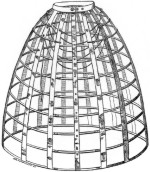The crinoline boasts as its great–great–grand–mother the farthingale or vertingale, which was worn in France in the reign of Henry II, when it is described as a cage put on beneath the petticoat to innate it to extravagant extent. It was, however, in the days of Elizabeth that the farthingale reached its apogee, and according to Sir Roger de Coverley made its wearers look as if they were “standing in a drum.” Early in Charles I’s reign it went out of fashion, and when Catherine of Braganza and her Portuguese ladies wore it on coming to London for her marriage with Charles II, the anachronism attracted crowds of amused spectators. The farthingale, in fact, had become obsolete, to reappear, however, in the somewhat more convenient form of the hooped petticoat which swelled in the reign of Anne. The contour of this was very slightly altered in the reign of George I, the sides being more curved at the front and the back, and the old shape of the circular farthingale was preferred with the trainless gown. 1796 is the date given when hoops were discarded except at Court, and the real crinoline made its appearance in 1854, the previous year having witnessed the crinoline petticoat as an ordinary adjunct to dress. The Empress Eugénie pronounced in favour of the crinoline, and it became the mode, remaining so for many years while those few who refused to give it patronage gave hostages to fashion in the horsehair–stiffen petticoat. The crinoline in those days was of the skeleton kind and formed of hoops of steel held together by perpendicular tapes, but it soon developed into a petticoat of calico with the steel running through it at intervals from hem to waist. It is amongst the fashions over which even most pessimistic may hopefully write “Ichabod.”
(c) Copyright 2004.

A late 1850s crinoline.